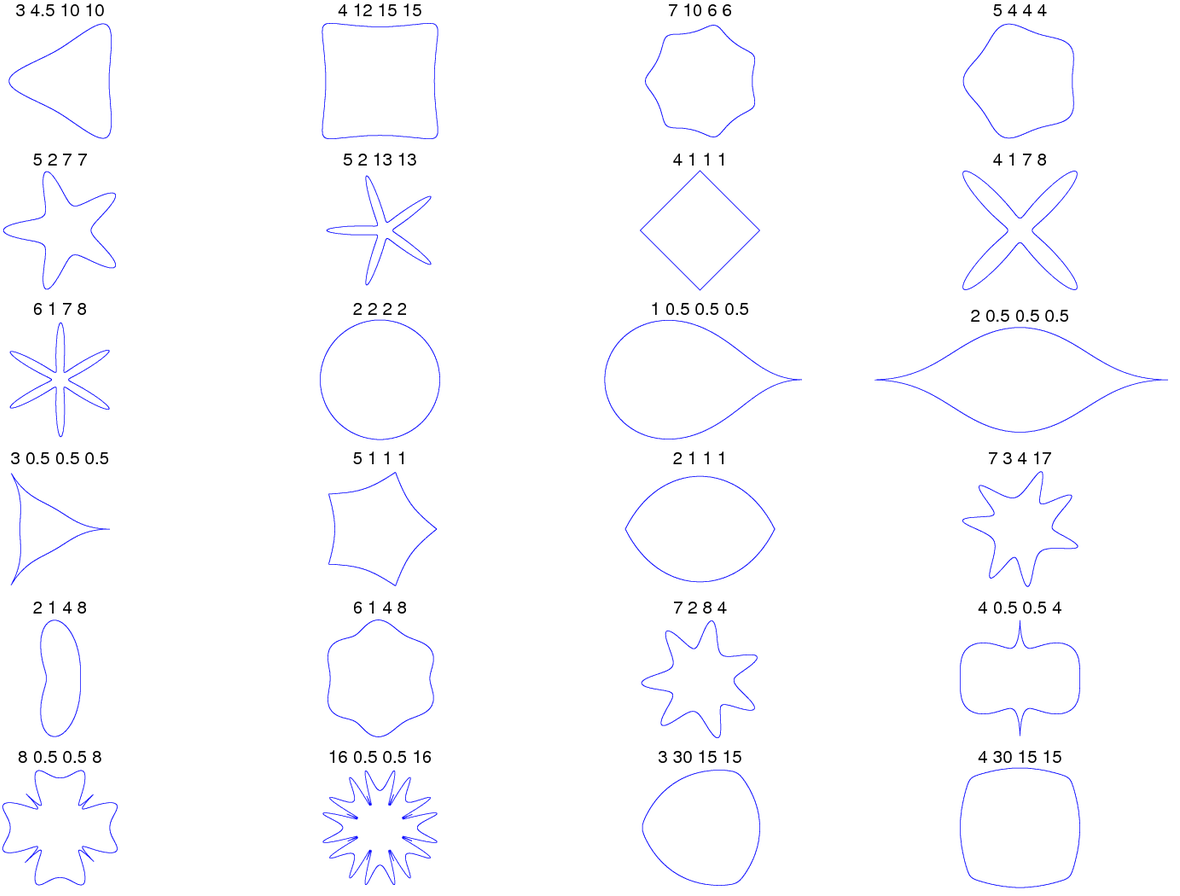home
> factoids
> superformula
The superformula is a generalisation of the circle, the ellipse,
and the superellipse, published by
Johan Gielis in 2003.
The equation of a circle of radius +++c+++ is:
$$
x^2 + y^2 = c^2 \mbox{ ; or } \left(\frac{x}{c}\right)^2 + \left(\frac{y}{c}\right)^2 = 1 \mbox{ ; or } r = c
$$
where +++x = r \sin \phi+++ and +++y = r \cos \phi+++.
The equation of an ellipse with semi-axes +++a+++ and +++b+++ is:
$$
\left(\frac{x}{a}\right)^2 + \left(\frac{y}{b}\right)^2 = 1
\mbox{ ; or }
r = \left[\left(\frac{\cos\phi}{a}\right)^2 + \left(\frac{\sin\phi}{b}\right)^2\right]^{-1/2}
$$
The superellipse
is a generalisation; the exponents can be any +++n+++, not just +++2+++:
$$
\left|\frac{x}{a}\right|^n + \left|\frac{y}{b}\right|^n = 1
\mbox{ ; or }
r = \left(\left|\frac{\cos\phi}{a}\right|^n + \left|\frac{\sin\phi}{b}\right|^n\right)^{-1/n}
$$
Gielis' superformula
is a further generalisation, allowing the three occurences of the exponent +++n+++ to vary independently,
and also allowing the frequency of the trigonometric functions to vary:
$$
r = \left(\left|\frac{\cos (m\phi/4)}{a}\right|^{n_a}
+ \left|\frac{\sin (m\phi/4)}{b}\right|^{n_b}\right)^{-1/n}
$$
With its many parameters, the superformula can describe a multitude of curves.
For example
(from the wikipedia superformula
page, individual curves labelled by +++(m,n,n_a,n_b)+++, all with +++a=b=1+++)

Below is a utility (written in Processing, and using
processing.js
for execution is a browser).
The scrollbars allow variation of +++m,n,n_a,n_b,a,b+++,
plus a further parameter +++cy+++ described in examples 6,7,8 below.
The buttons labelled +++0..24+++ provide +++25+++ predefined value sets,
displaying a range of possible superformula images.
The values of +++m+++ are restricted to be multiples of +++\frac{1}{4}+++;
the values of +++n,n_a,n_b+++ are restricted to be multiples of +++\frac{1}{2}+++.
Predefined images (selected using the numbered buttons):
- +++(4, 2, 2, 2, 1, 1, 1)+++ : A circle;
+++m=4+++ removes the frequency change;
+++n = n_a = n_b = 2+++ is the squared exponent;
+++a = b+++ makes it a circle.
- +++(4, 2, 2, 2, 1.8, 0.5, 1)+++ : An ellipse;
+++m=4+++ removes the frequency change;
+++n = n_a = n_b = 2+++ is the squared exponent;
+++a \neq b+++ makes it an ellipse rather than a circle.
- +++(4, 3, 3, 3, 1.8, 0.5, 1)+++ : A superellipse;
+++m=4+++ removes the frequency change;
+++n = n_a = n_b \neq 2+++ is the non-squared exponent.
If +++n = n_a = n_b = 1+++, the superellipse is a rhombus (see example 16);
if +++n = n_a = n_b \lt 1+++, the sides of superellipse are concave.
- +++(8, 2, 10, 10, 1, 1, 1)+++ : An eight-pointed star.
- +++(3, 5, 18, 18, 1, 1, 1)+++ : A three-pointed star.
- +++(5, 1, 2, 15, 1, 1, 1)+++ : An asymmetric five-pointed star.
- +++(7, 4, 4, 17, 1, 1, 1)+++ : An asymmetric seven-pointed star.
- +++(7, 4, 4, 17, 1.3, 1, 1)+++ : An asymmetric seven-pointed star with a gap; +++a \neq b+++.
Because +++m+++ is not an even integer, the frequency term means the value of +++r+++
is different when +++\phi = 0+++ and when +++\phi = 2\pi+++.
When +++m+++ an odd integer, as here, it is easy to show that
+++r(0) = a^{n_a/n}; r(2\pi)=b^{n_b/n}+++.
For the curve to join up, we need +++a^{n_a/n}=b^{n_b/n}+++.
One way to achieve this is +++a=b=1+++ (as in the previous example);
another is +++a=b\neq 1, n_a=n_b+++.
- +++(7, 4, 4, 17, 1.3, 1, 2)+++ : An symmetric seven-pointed star with two cycles; +++cy = 2+++.
A further way to make the curve join up for odd +++m+++ is to plot +++\phi+++ from +++0+++ to +++4\pi+++,
or +++2+++ cycles, +++cy = 2+++.
When +++m+++ is half-integral, we need +++cy=4+++; when it is quarter-integral, we need +++cy = 8+++.
Other fractional values (not supported here) would require different values of +++cy+++;
irrational values of +++m+++ would never join up, no matter how large +++cy+++.
- +++(12, 15, 20, 3, 1, 1, 1)+++ : A fancy dinner plate.
- +++(19, 9, 14, 11, 1, 1, 1)+++ : Nineteen spike.
- +++(18, 9, 18, 17, 1, 1.5, 1)+++ : Crinkly spikes.
- +++(17.75, 9, 18, 17, 1, 1.5, 8)+++ : Crinkly spikey flowerhead; +++m=17.75+++,
so +++cy=8+++ for a closed curve.
- +++(16, 1, 1, 19, 1, 1, 1)+++ : Crinkly, less spikey.
- +++(2, 1, 4, 8, 1, 1, 1)+++ : A bean.
- +++(3, 5, 20, 20, 0.7, 1.2, 2)+++ : Overlapping trefoils.
- +++(4, 1, 1, 1, 1.5, 1.5, 1)+++ : The diamond (rhombus) superellipse; +++m=4;+++ +++n = n_a = n_b = 1+++.
- +++(4, 1, 8, 8, 0.9, 0.9, 1)+++ : A four-pointed star.
- +++(6, 1, 1, 1, 1.8, 1.1, 1)+++ : A lumpy triangle: six-pointed, but very differing sizes.
- +++(10, 1, 1, 1, 1.8, 1.1, 1)+++ : A lumpy starfish.
- +++(5, 2, 17, 4, 0.8, 1.5, 2)+++ : A five-petalled flower.
- +++(9, 2, 17, 4, 0.8, 1.5, 2)+++ : A nine-petalled flower.
- +++(2.5, 0.5, 0.5, 0.5, 2, 2, 2)+++ : Rose sepals.
- +++(8, 0.5, 0.5, 8, 1.9, 1.05, 1)+++ : A spikey four-leafed clover.
- +++(18, 0.5, 0.5, 4, 1.2, 1.1, 1)+++ : A virus.

